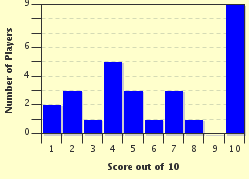Quiz Answer Key and Fun Facts
1. This is the largest of the Inner Hebrides; the varied landforms here include the Cuillins and the Quiraing.
2. One of the Isles has separate names for the north and south parts. The southern part is called Harris, what is the northern part? To a non-Gaelic speaker, both parts sound like surnames.
3. The airport here is on the beach, making flight times dependent on the tide.
4. You can find eight distilleries here (with more planned).
5. This island, dominated by its 'Paps', is where George Orwell stayed in 1948 while writing "1984".
6. The Corryvreckan whirlpool lies between this uninhabited island and Jura.
7. The restored Abbey here is both a tourist destination and a spiritual retreat.
8. This fertile, low-lying island, noted for its combination of sunshine and wind, is a venue for world-class windsurfing.
9. The 'Bridge over the Atlantic' has linked this island to the mainland for over two hundred years.
10. A naturalist's paradise, this island is host to well over two thousand plant species, and over two hundred and fifty different birds.
Source: Author
Radain
This quiz was reviewed by FunTrivia editor
agony before going online.
Any errors found in FunTrivia content are routinely corrected through our feedback system.

